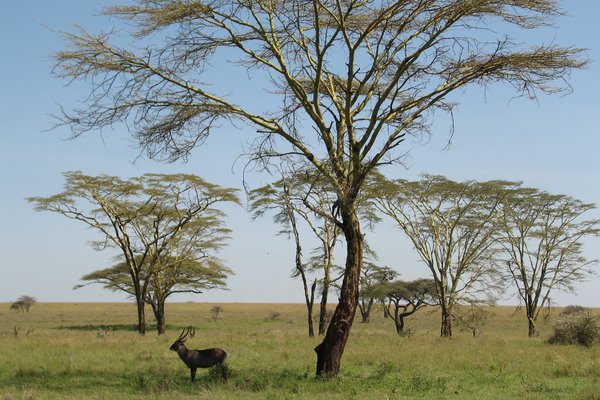Tanzania
Serengeti
Serengeti National Park is a large area of savanna and open woodland that is renowned for the annual migration of its wildebeest.
The park has the largest herds of grazing animals in the world, including more than 2 million wildebeest, 900,000 Thomson's gazelles and 300,000 zebras. Predators include 4,000 lions and 1,000 leopards. Twice a year, nearly 2 million herbivores migrate in pursuit of the rains and cross the Mara River.
Community Perspective: Large predators such as lions, leopards and cheetahs are easy to see here. Try to time your visit with the wildebeest migration, although that will raise the cost of what is an already expensive visit even more.
Site Info
Official Information
- Full Name
- Serengeti National Park (ID: 156)
- Country
- Tanzania
- Status
-
Inscribed 1981
Site history
History of Serengeti
- 1981: Inscribed
- Inscribed
- Type
- Natural
- Criteria
- vii
- x
Links
- UNESCO
- whc.unesco.org
- Official
-
- tanzaniatourism.go.tz — Tanzania tourism: Serengeti National Park
- Related
-
- serengeti.org — Serengeti Conservation Project
All Links
UNESCO.org
- whc.unesco.org — whc.unesco.org/
Official Website
- tanzaniatourism.go.tz — Tanzania tourism: Serengeti National Park
Related Resources
- serengeti.org — Serengeti Conservation Project
News Article
- July 1, 2011 news.nationalgeographic.com — Hold the Champagne: Highway to Split Serengeti After All?
- Sept. 30, 2010 eturbonews.com — UNESCO fires warning shot over Serengeti Highway
Community Information
- Community Category
- Wildlife habitat: Fauna
- Natural landscape: Grassland and tundra
Travel Information
High entrance fees
Recent Connections
-
Perfect Inscriptions
1981 -
Location for a classic documentary
"Serengeti Shall not die" (1959)See en.…
-
Savanna
"the vast plains of Serengeti National …
Connections of Serengeti
- Individual People
-
-
Ernest Hemingway
In 1933 Hemingway and Pauline went on safari to East Africa. The 10-week trip provided material for Green Hills of Africa, as well as the short stories "The Snows of Kilimanjaro" and "The Short Happy Life of Francis Macomber". They visited .... the Serengeti (WIki)
-
- Geography
-
-
Contiguous National Sites
Abuts Ngorongoro Conservation Area -
On National Border
On Kenya border
-
- Trivia
- Ecology
-
-
Elephants
African elephant -
Lions
"Serengeti National Park forms a Lion Conservation Unit since 2005 together with Maasai Mara National Reserve.[10] More than 3,000 lions live in this ecosystem." (wiki)See en.wikipedia.org
-
Mammal Migrations
Wildebeest -
Ratites
common ostrich -
Strepsirrhini
brown greater galago -
Inselbergs
"The Serengeti plain is punctuated by granite outcroppings known as kopjes. These outcroppings are the result of volcanic activity. Kopjies provide a microhabitat for non-plains wildlife. One kopje likely to be seen by visitors to the Serengeti is the Simba Kopje (Lion Kopje). The Serengeti was used as inspiration for the animated Disney feature film The Lion King and subsequent theatrical production. (Wiki) -
Over 300 bird species
"There are over 500 species of birds that are perennially or seasonally present in the Park" (OUV) -
Flamingos
"They can mostly be found in the southern Serengeti plains, Ndutu area, northern Serengeti and the Serengeti Grumeti Area" -
Big Five
-
Critically endangered fauna species
Black Rhinoceros - General: "Population size collapsed during the last century, from an estimated 65,000 animals in 1970 to a mere 2,300 in the 1990s. Rhino numbers are now increasing, but recovery is slow"; in Serengeti NP: "very few individuals remain due to rampant poaching" -
Somalia-Masai regional centre of endemism
-
Bovines
70,000 buffalos (OUV) -
Rhino habitat
Eastern black rhinoceros -
Savanna
"the vast plains of Serengeti National Park, comprising 1.5 million hectares of savannah" (OUV) -
African Wild Dog
"The rich fauna of large herbivores supports no less than 5 major predators, including 4,000 lion, 1,000 leopard, 225 cheetah, 3,500 spotted hyena, and 300 wild dog" (AB eval) -
Hippos
500 hippopotamuses (OUV)
-
- Damaged
-
-
'Threatened' by Roads
Arusha- Musoma Highway -
Covered by volcanic ash
The underlying soils and materials of the Serengeti plains are comprised of volcanic ash derived from a number of local volcanoes. The dormant caldera of Ngorongoro, the Kerimasi Volcano and Mt Lengai (last eruption in 1966) have all contributed volcanic ash to these soils (vertisols). These soils have characteristic plant communities, distinguishing the ecoregion from its neighbors.
-
- World Heritage Process
-
-
Perfect Inscriptions
1981 -
Extensions on Tentative List
The Great Rift Valley - The Maasai Mara - The site should be listed as across boarder site as the United Republic of Tanzania has taken the first initiative -
Potential Transboundary sites
Kenya : The Great Rift Valley - The Maasai Mara -
Extension Supported
"NB The Committee urged the competent authorities of Tanzania to consider adding the Maswa Game Reserve to this World Heritage site." (Decision 5 COM VIII.15)
-
- Human Activity
-
-
Indigenous groups expelled
Maasai. Anglo-Maasai Agreement 1958 – “Under this agreement, the Maasai were expected to have moved out of Serengeti National Park by 31 December 1959 and in the main they had moved by the deadline. Some force was used against those who remained past the deadline, and all were considered gone by the end of 1960”
-
- WHS on Other Lists
-
-
World Biosphere Reserves
Part of Serengeti-Ngorongoro (1981) -
WWF Global 200
Terrestrial, Tropical and Subtropical Grasslands, Savannas and Shrublands: (87) East African Acacia Savannas (subregion Serengeti volcanic grasslands)
-
- Visiting conditions
-
-
Foreigner prices
30 versus 60 USD conservation fee. Residents and East African citizens get the local fee as well. -
High entrance fees
70.8 US dollar (daily charge, 2021)
-
- Literature & Film
-
-
Location for a classic documentary
"Serengeti Shall not die" (1959)See en.wikipedia.org
-
News
- news.nationalgeographic.com 07/01/2011
- Hold the Champagne: Highway to Spl…
- eturbonews.com 09/30/2010
- UNESCO fires warning shot over Ser…
Recent Visitors
Visitors of Serengeti
- Afshin Iranpour
- AK
- Alberto Rodriguez Gutierrez
- alex
- Alex Baranda
- alicemears
- Alikander99
- Ali Zingstra
- A. Mehmet Haksever
- amychemu
- Andrea Szabo
- arnaugir
- Ask Gudmundsen
- Aspasia
- Atila Ege
- Brett Baumann
- Carlo Medina
- Carlo Sarion
- chapnis
- Christoph
- Crinion
- Csaba Nováczky
- dave wood
- David Marton
- Deffra
- Dirk-pieter
- Dolemite92
- DouglasR
- Drk9Stormy
- Elf21
- Els Slots
- Eric Lurio
- Eva Kisgyorgy
- fedemarch92
- Fernweh
- Geert Luiken
- Gernot
- Grzegorz Andruszkiewicz
- Harald T.
- Harry Mitsidis
- Hdwilsonau
- Iain Jackson
- Ingrid
- IreneKD
- Jacob Otten
- Jana and Matt
- Janos
- Jarrod_Byham
- Javier
- Javier Coro
- jballard650
- Jeanne OGrady
- JJ10
- Joel on the Road
- Jonas Martinsson
- jonathanfr
- Joyce van Soest
- JR's HERITAGE SITES
- KarenBMoore
- Kbecq
- KeithBailey
- kelseyyurek
- Little Lauren Travels
- Lucio
- Ludvan
- Luis Filipe Gaspar
- Lukemarshall
- Maja
- Malgorzata Kopczynska
- Marinemajor
- Marlies van Wolfswinkel
- Martin
- maryhattie
- Mathijs
- Matthewrw
- MAURO PODDA PANI
- Michael Ayers
- Michael Novins
- Mikko
- Morodhi
- Mstrebl1990
- Mtlmr
- Nihal Ege
- Nuria8
- PabloNorte
- Paul Schofield
- Peltzi
- petar
- Pieter Dijkshoorn
- Pink Bunny
- Piotr Wasil
- Potsdamer
- Priyaranjan Mohapatra
- Rahelka
- Randi Thomsen
- Roman Bruehwiler
- Sandra!
- sbshipway
- Shandos Cleaver
- Shannon O'Donnell
- Sofia84
- Solivagant
- Squiffy
- Sutul
- Svein Elias
- Szucs Tamas
- Thomas Buechler
- Tim Allen
- Timothy C Easton
- Toxicologist
- triathlete_16
- Vanessa Buechler
- voyager
- Waxwing
- Wojciech Fedoruk
- Wo_ko
- ZCTLife
- zfish
- Zizmondka
- Zoë Sheng
- Zsuzsanna Forray
Community Reviews
Show full reviews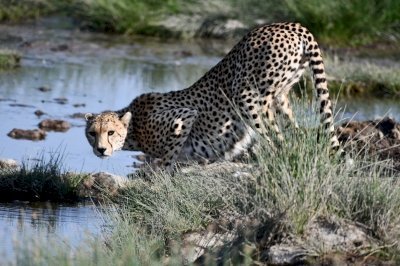
The plain of Serengeti has been a myth to me since childhood. I loved watching these wild and dangerous animals on TV. Now it was my turn to explore it live!
Having spent two weeks in Tanzania at this point we were well adjusted and used to being here, but nevertheless – it’s a special feeling passing the Naabi Hill gate and entering the park.
By leaving our Ngorongoro lodge on the rim in the morning and visiting the Olduvai site on the way it was already noon when we entered the park, but as we were staying for three nights there would be enough time to explore this enormous plain.
The first experience meeting us in this eastern part of the part was all the kopjes (the rock formations) scattered around with its special vegetation, as taken straight out of Disney’s The Lion King movie. While driving to the park we had animal encounters all morning, but around these kopjes we didn’t have any luck, to our and our guide’s disappointment. But soon after we had our first male lion within sight – resting on a tree branch. We were told that tree climbing lions were rare, but in fact we saw many of them. Shortly after we found a leopard resting the same way, which is more common. Five hours later and several animal encounters we arrived in Mawe Tented Camp for the night. It is a camp without much extravaganza, but still very nice. …
Keep reading 0 comments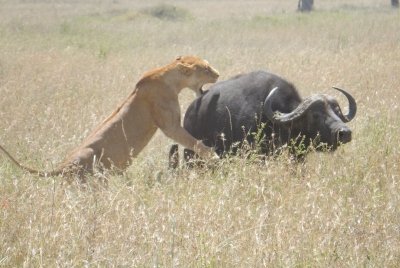
The buffalo were nervous. Their ears twitched as they shifted uncomfortably. Visibly reaching a collective decision, they turned and started to walk away from our vantage point. It was at that point the first lioness appeared, padding purposefully through the long grass. First one, then another, then two more lionesses joined her. The buffalo started to run. So did the lions. The buffalo stampeded. Their galloping hooves threw up clouds of dust. And the lions were right on their tail. The herd turned as one to the right… except for one. One buffalo turned left. We have watched more than our fair share of David Attenborough documentaries. We knew what that meant. A lioness sprang onto the back of this lone buffalo, sinking claws and teeth into his black hide. That checked his run long enough for a second to leap aboard. He fought, bellowing and bucking. But the game was over for him. If he dislodged one lion another would take its place, using their superior numbers to tag-team him. One ran in from behind to nip at his hamstrings. One approached from the front and sank her jaws into his muzzle. Starved of breath he quietened. His bellows softened to snorts and then to gasping moans. He fell to his knees. Then, as one, the lionesses relaxed their grip and stepped back. It was over.
Before we arrived in Africa we had asked ourselves how we would react to seeing a hunt in progress. We had both …
Keep reading 0 comments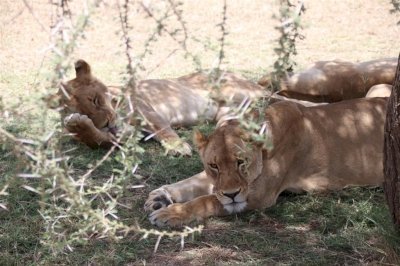
We visited Serengeti National Park for three days at the end of September and it did not disappoint.
Since we were based in Moshi after our Kilimanjaro climb, we first had to make a long drive to the park passing Lake Manyara and the Ngorongoro crater (which we visted afterwards).
Once in Serengeti, you will encounter countless animals (giraffes, zebras, gazelles, monkeys, elephants, the bizarre hyrax, ...). Over three days, we also spotted a dozen of lions – most of them resting under a tree in small groups but also one hunting a gazelle. Little anecdote in this respect: three meters away from a couple of resting lions, our jeep found it a good idea to stop working but another nearby jeep was radioed and was able to give us a push which helped us start again.
We were also lucky to see a number of cheetahs (be it from a distance), a lazy leopard in a ‘sausage tree’ and what looked like a miniature version of the wildebeest migration (an endless stream of wildebeests and zebras crossing the road but only in a single line). Another – be it smelly – highlight is the hippo pool.
Although most people visit Serengeti for the wildlife, the surroundings are also beautiful and worthwile to spend a couple of days, so in our opinion Serengeti is one of the top WHS!
In terms of accomodation, there are various options: lodges, moving camps (to follow the wildebeest migration), …
Keep reading 0 comments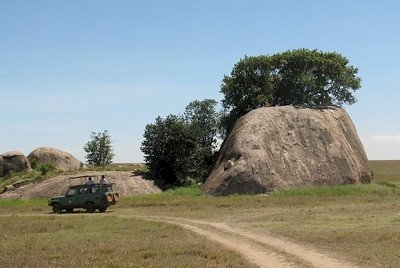
At 8 a.m. we leave for the day-long safari through the Serengeti. Our lodge, the Ndutu Lodge, lies outside the boundaries of the park and therefore we must first take a ride on the plains until we reach the Naabi Hill Gate. Underway, we already see plenty of animals, especially a lot of gazelles and the first hyena.
The Serengeti seems a big dry plain but there still are some small pools of water. In one of them, about twenty hippos are submerged. They look like a group of stones as they have their heads underwater. Only very occasionally they show their nostrils above the waterline.
The first real predators that we see are the Cheetahs. First four at some distance, and then another two fairly close. They were sitting under a tree but when they see the jeep they walk away slowly.
The park also has many different kinds of deer and antelope. In addition to the ubiquitous gazelles, we see impalas, hartebeests and Bohor bucks. They all stand around in small groups along the sandy road that we must follow with our jeeps. If a jeep stops, they look up and pull back a bit, but they are not really skittish.
Then the time has come for the search for lions. Search is a relative concept here because the jeep drivers have a radio on board to keep each other informed. Also, oncoming jeeps are often asked for information. A group of four lions …
Keep reading 0 comments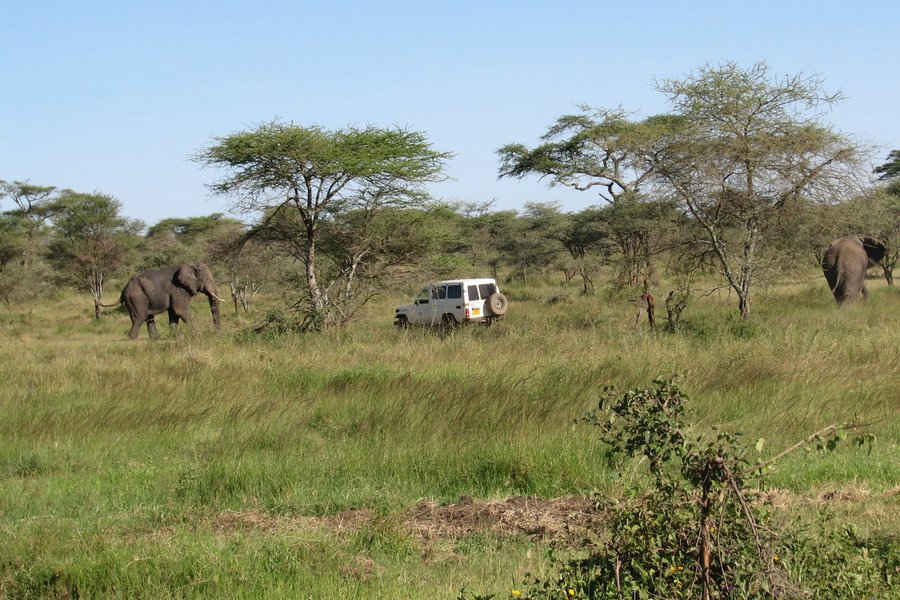
Recently visited Seregheti NP too on our honeymoon in early July (see Ngorongoro Crater NP). Weather was amazing. Mid-eighties and no humidity. Being the dry season the tsetse flies and mosquitos were not a problem. Had timed our trip for the Wildebeast migration. The beginning of our Safari with Thomson tours (without the "p", which I highly recommend) started at Tarangire NP where the migrating herds had left the week prior to our arrival. However we caught up with the herds in the western corridor of the Serengeti NP. Amazing! A vast expanse of grassland inhabited by millions of animals as far as the eye can see. And best of all, not one radio-tower with flashing red lights to spoil the view in the distance. Coming into the park via the Naabi Hill gate and traversing the endless flat plain is truely a sight to behold. You realize what a small speck you are on this earth. I would recommend visiting early/mid-June to avoid possibly missing the herds in Tanzania (they migrate to Kenya). The Kirawira Luxury camp is exquisite. The people of Tanzania are extremely friendly to foreigners and the use of English is spreading rapidly, thus making travel more comfortable for us westerners. I highly recommend seeing this eden.
Keep reading 0 comments
